Why Quick-Deploy Solutions Are Revolutionizing Emergency Response
Quick-deploy- solutions are changing how organizations respond to emergencies and scale operations rapidly. These tools enable deployment in minutes rather than hours or days, using pre-configured setups that require minimal technical expertise.
Key Quick-Deploy Categories:
- Cloud & Software: AWS Quick Starts, Terraform templates, automated CI/CD pipelines
- Hardware & Equipment: Spring-loaded bipods, portable weather stations, rapid-deploy coolers
- Specialized Tools: Morgue surge solutions, emergency shelter systems, field communication gear
- Deployment Time: Ranges from 2 minutes (AWS OpenVPN) to 30 days (DocLink AP automation)
- Common Benefits: Reduced labor costs, faster time-to-value, standardized configurations
The research shows dramatic time savings across industries. AWS Quick Starts deploy complex cloud infrastructure in minutes by automating hundreds of manual procedures. The FTS Quick Deploy Portable Weather Station sets up in 15 minutes by one person with no tools. DocLink's methodology enables organizations to go paperless in 30 days.
These solutions share common traits: tool-free assembly, pre-configured settings, and streamlined processes that eliminate traditional deployment bottlenecks.
I'm Mortuary Cooler from American Mortuary Coolers, and I've spent years helping funeral homes implement quick-deploy- cooling solutions during surge situations and emergency response scenarios.
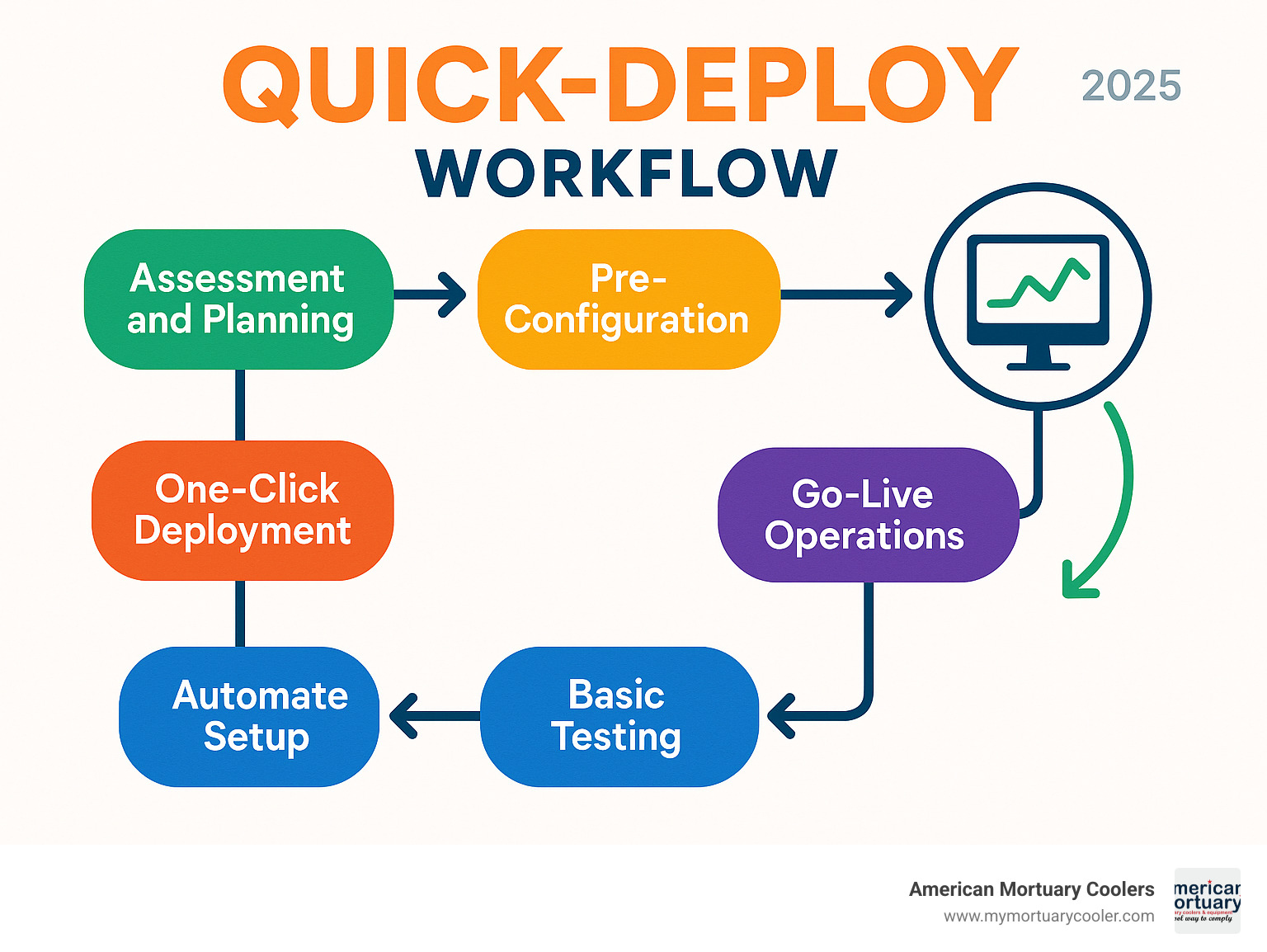
Quick-deploy- vocab explained:
What Does quick-deploy- Mean Across Industries?
The term quick-deploy- takes on unique meanings across different industries, but all share the same core promise: getting critical systems up and running fast when time matters most.
In the IT and cloud world, quick-deploy means automated infrastructure that sets itself up. AWS Quick Starts act as digital assistants that deploy complex technology stacks in minutes instead of weeks using Infrastructure as Code.
The hardware and field equipment sector focuses on designs that work right out of the box with no tools required. The FTS Quick Deploy Portable Weather Station exemplifies this - one person can have it operational in 15 minutes without technical background or tools.
For the funeral and mortuary industry, quick-deploy solutions became critical during emergencies. Quick-deploy- morgue racks use collapsible designs, while rapid-deploy coolers can be operational within hours when families need services most.
Quick-Deploy Basics for Cloud & Software
Cloud quick-deploy solutions work through automation and Infrastructure as Code. The Elastic quick-deploy system on GitHub demonstrates this - users can have Elasticsearch and Kibana running in 2 minutes using Docker containers.
AWS Quick Starts represent the gold standard, handling hundreds of configuration steps automatically. Their OpenVPN Quick Start creates secure VPN connections in about 2 minutes with one click.
Kubernetes manifests offer another approach. The bcgov quickstart-openshift project shows how development teams can automatically create isolated testing environments from code changes.
Quick-Deploy Hardware & Field Gear
Hardware quick-deploy- solutions focus on clever mechanical design. Spring-loaded mechanisms, tool-free assembly, and pre-configured settings are key.
Harris quick-deploy bipods showcase this engineering. Their spring-loaded legs lock into position in under a second, with precise adjustments as small as one inch. Whether you need 6-9 inch or 13.5-27 inch range, these systems deploy instantly.
The FTS Quick Deploy Weather Station revolutionizes environmental monitoring. Unlike cheaper units requiring assembly, this system ships preconfigured and ready to transmit data immediately. The telescoping mast extends without tools, perfect for fire management teams.
In our specialized field, rapid-deploy morgue coolers address sensitive capacity challenges. These systems combine portability for emergency deployment with reliability required for important work. Modern solutions like the Mortech MERC System use advanced direct-contact liquid cooling technology designed specifically for our industry.
Benefits and Trade-Offs of Quick-Deploy Solutions
When considering quick-deploy- solutions, you're weighing speed against flexibility. These systems transform emergency response but come with important considerations for long-term operations.
The biggest win is faster time-to-value. DocLink Quick Deploy helps organizations transform paperwork processes in 30 days. One customer eliminated hiring additional staff and saved $100,000 annually. Another saved $20,000 on supplies and freed up storage space.
Lower labor requirements make a huge difference during emergencies. The FTS weather station illustrates this - one person can have it running in 15 minutes, no team or specialized tools needed. Compare that to traditional installations requiring multiple technicians and half a day.
Standardized configurations reduce human error and ensure consistent results. Citrix DaaS Quick Deploy automatically sets up resource locations and creates delivery groups without manual intervention. This keeps deployments predictable, though it limits customization.
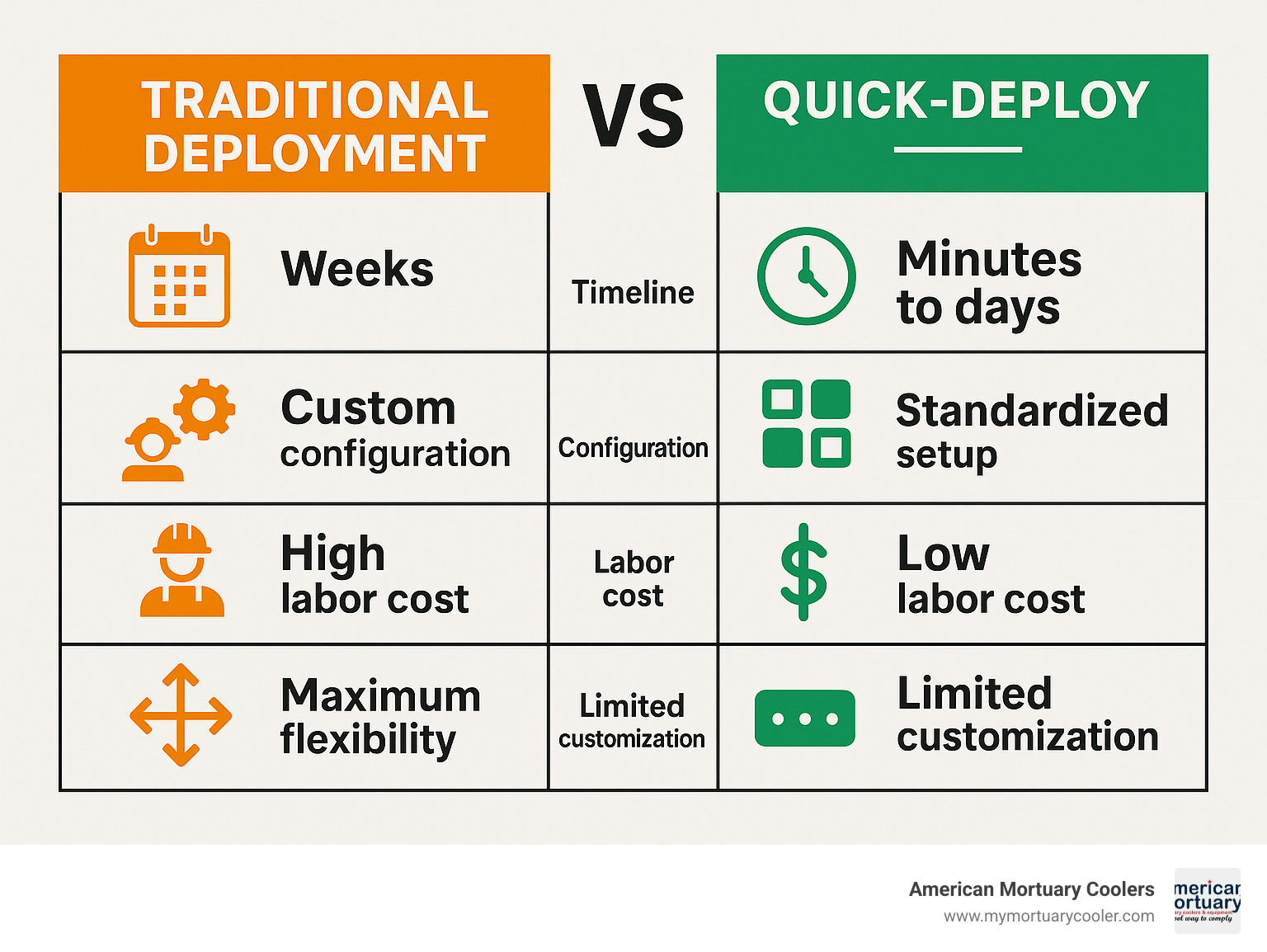
Key Advantages of quick-deploy- in Critical Scenarios
During disaster response, quick-deploy- solutions become essential. Fire crews using FTS portable weather stations can reposition multiple units along burn lines in under 30 minutes, getting instant voice alerts about critical weather changes.
Scaling becomes manageable during surge events. Ready Response Systems help facilities handle sudden capacity increases. Whether dealing with pandemics, natural disasters, or emergencies, quick-deploy morgue solutions expand capacity rapidly without specialized installation teams.
Resource savings add up over time. The elastic quick-deploy script eliminates manual Docker installation by automatically handling prerequisites and launching containerized services, saving time and reducing required technical expertise.
Common Limitations to Watch For
Customization caps represent the biggest limitation. Citrix Quick Deploy only supports Azure workloads with basic configuration options, while Full Configuration supports multiple cloud hosts and advanced features. Complex requirements might find quick-deploy solutions too restrictive.
Vendor lock-in can become problematic. Many solutions use proprietary templates making migration difficult. AWS Quick Starts are powerful but tie organizations to AWS infrastructure, potentially creating migration challenges.
Security baselines might not meet all requirements. Quick-deploy solutions implement standard security configurations that work for most cases but may lack specific hardening required for highly regulated industries.
Popular Quick-Deploy Tools, Products, and Platforms
The quick-deploy- world is surprisingly diverse, spanning everything from cloud servers to weather stations to specialized mortuary equipment. What makes these tools special isn't just their speed - it's how they eliminate the usual headaches that come with traditional deployments.
Latest research on automated cloud deployments reveals that AWS Quick Starts have become the gold standard for cloud infrastructure. These aren't just faster - they're smarter. The AWS Quick Start for OpenVPN proves this point beautifully, creating secure VPN tunnels in about 2 minutes. Compare that to manual VPN setup, which typically takes hours and plenty of troubleshooting.
Citrix DaaS Quick Deploy takes a different approach, focusing specifically on Microsoft Azure environments. Instead of overwhelming users with options, it provides just enough configuration choices to get desktop virtualization running quickly. The system automatically handles the technical backend work - resource locations, Cloud Connectors, and delivery groups - so IT teams can focus on users rather than infrastructure.
Mapbox Quick Launch serves the emergency response community with situational awareness dashboards that work both online and offline. The drag-and-drop interface means field teams can build custom dashboards without waiting for IT support. During emergencies, this speed can literally save lives.
DocLink Quick Deploy represents a completely different sector - document management. Their 30-day paperless change might sound too good to be true, but they've refined their process over 25 years. The fixed deployment methodology eliminates the usual scope creep and timeline surprises that plague traditional software implementations.
OpenShift QuickStart templates provide another cloud option, focusing on container platforms and microservices. These templates automate the complex orchestration needed for modern applications, turning weeks of manual configuration into minutes of automated deployment.
For specialized equipment, the hardware side gets equally interesting. Portable morgue racks use collapsible designs that require minimal assembly, while quick-deploy bipods employ spring-loaded mechanisms for instant positioning. Each solution tackles the same basic challenge - eliminating setup complexity while maintaining professional-grade performance.
More info about Step-by-Step Guide to Quick Deploy Tools provides deeper insights into deployment strategies across these different categories.
Software & Cloud Stacks
Terraform OCI CPE brings Infrastructure as Code principles to Oracle Cloud Infrastructure, specifically for Customer-Premises Equipment. This solution eliminates the manual networking configuration that typically frustrates IT teams during cloud migrations. The templates handle VPN connections, security groups, and routing automatically.
OpenVPN CloudFormation templates showcase how cloud automation should work. Deploy the template, wait about 2 minutes, and you have a fully configured VPN infrastructure complete with client certificates. The solution automatically selects the right Amazon Machine Images for your region and configures security groups according to best practices.
The GitHub elastic quick-deploy script proves that simple solutions often work best. This shell script checks for Docker and Docker-Compose, installs them if missing, then launches Elasticsearch and Kibana containers. While it's designed for development environments only, it demonstrates how a few lines of code can eliminate hours of manual setup.
Hardware & Equipment Line-Up
FTS Quick Deploy Weather stations serve fire management teams who need environmental data fast. These units ship preconfigured to user specifications, so there's no field programming required. The 15-minute setup time includes full deployment and telemetry activation. The rugged construction uses metal components throughout - no plastic parts that might fail during critical operations.
Rapid-Deploy Morgue Cooler systems address surge capacity needs that unfortunately arise during disasters, pandemics, and other emergencies. These portable units can be operational within hours of delivery, providing the reliable cooling that sensitive applications require. The MERC System technology offers direct-contact liquid cooling specifically designed for mortuary applications.
Quick-deploy legs bipods serve precision shooting applications with spring-loaded mechanisms that lock into position instantly. Harris bipods offer multiple extension ranges, from compact 6-9 inch models to extended 13.5-27 inch versions. The spring-loaded legs deploy with consistent tension and can be adjusted in 1-inch increments for precise positioning.
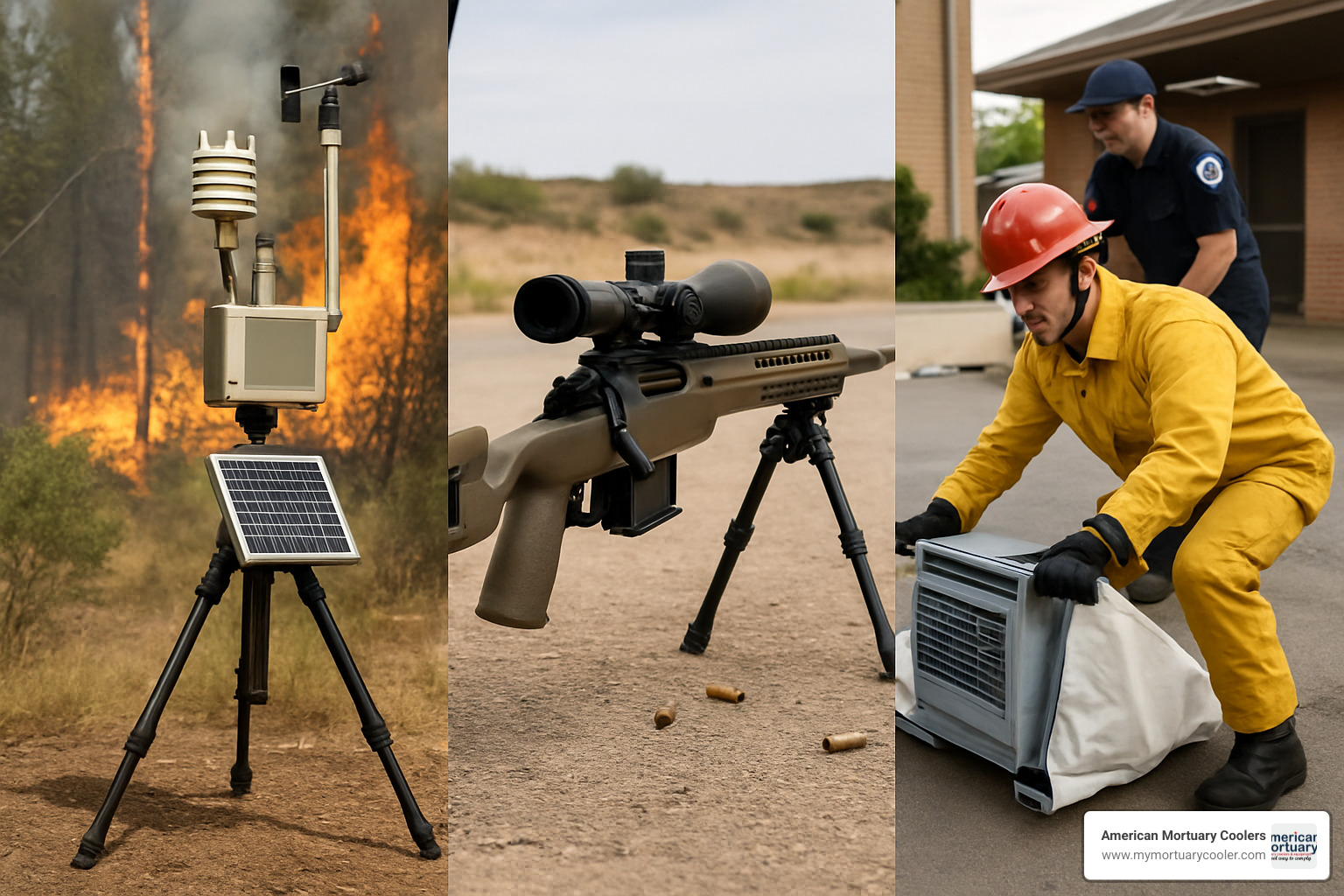
quick-deploy- Process vs Traditional Deployment
When facing emergencies - sudden surges or equipment failure - the difference between quick-deploy- and traditional deployment can mean managing the crisis versus being overwhelmed.
Traditional deployment feels like building from scratch every time. You start with requirements gathering, move through system design, then tackle infrastructure piece by piece. Each step requires specialized knowledge, coordination, and time. Funeral homes often wait weeks for traditional cooling solutions.
Quick-deploy processes flip this approach. Instead of starting from zero, these solutions front-load complex work into pre-configured templates and automated systems. It's like having a fully stocked emergency kit ready to deploy immediately.
Gearset Quick Deploy shows this in software - it becomes available when deploying from validated branches, skipping full validation because heavy lifting was done upfront. The same principle applies to our quick-deploy- morgue coolers.
Prerequisites shift dramatically. Traditional deployments demand detailed specifications, site surveys, and planning meetings. Quick-deploy solutions need just basics - access credentials for software or space measurements for hardware.
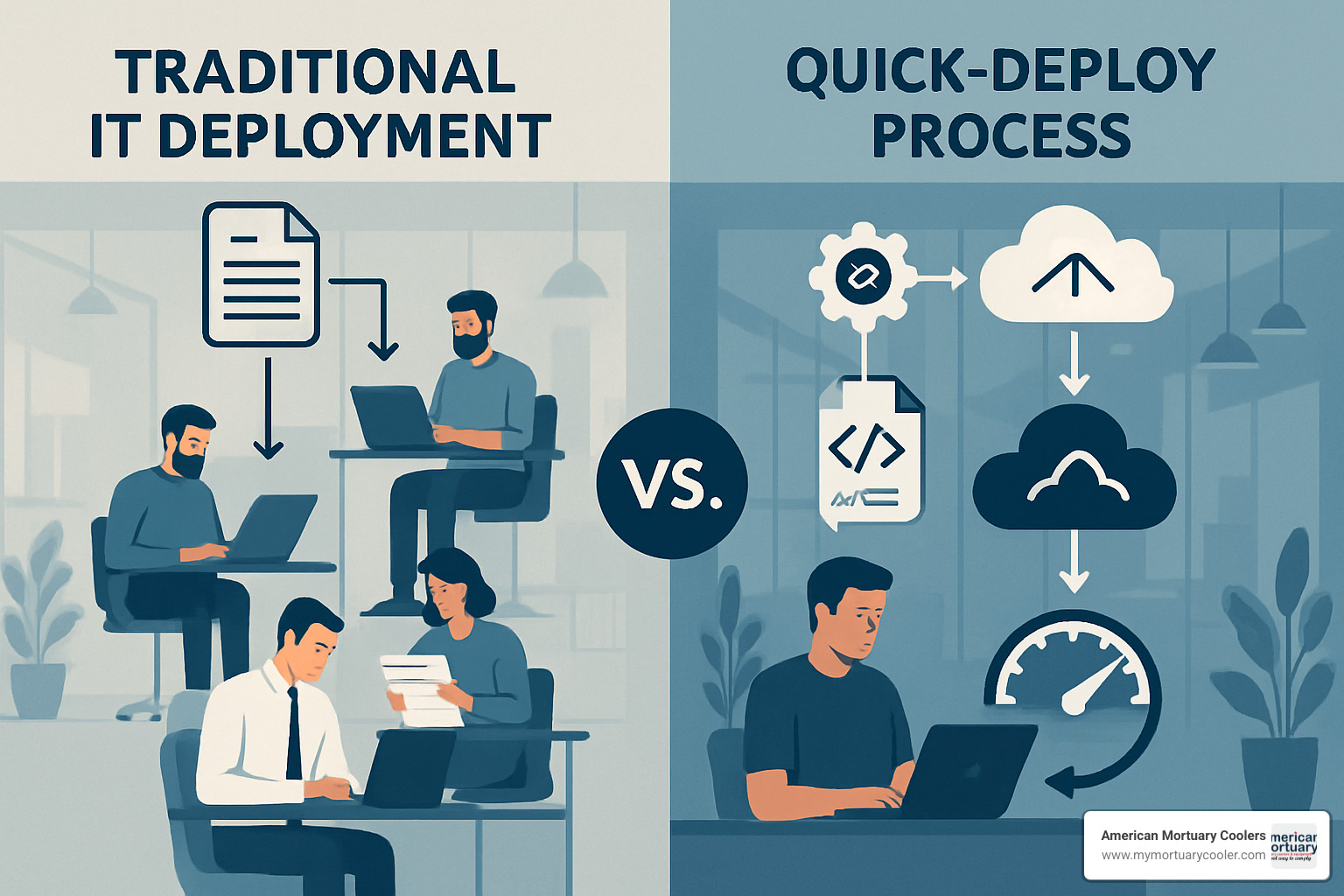
The 9 Typical Steps in a Quick-Deploy Run
Every quick-deploy- process follows similar patterns, whether setting up cloud infrastructure or emergency cooling capacity.
Planning starts with selecting the right template for your needs. This isn't custom design - it's matching your situation to proven configurations.
Validation ensures you have everything needed before starting. Modern systems check prerequisites automatically, preventing missing requirements finded mid-deployment.
Packaging bundles your settings with standard configuration. The bcgov/quickstart-openshift repository exemplifies this with pull request workflows handling the entire pipeline.
Auto-provisioning executes deployment without manual intervention. Scripts and templates that would take hours run in minutes.
Configuration applies your settings on standard baselines. Security gets implemented automatically, followed by automated testing.
Monitoring activates immediately. Final optimization fine-tunes performance based on actual usage rather than theoretical requirements.
Security, Configuration, and Customization
Security in quick-deploy- environments implements proven security patterns automatically. Cloud connectors in systems like Citrix Quick Deploy create secure communication without requiring security expertise.
Infrastructure as Code secrets management maintains security while enabling speed. The bcgov/quickstart-openshift guide shows how GitHub secrets handle sensitive information securely.
Compliance considerations get built into solutions rather than added afterward. Our cooling systems meet UL listings, NSF certification, and Federal requirements through standardized designs.
Role-based access controls prevent unauthorized deployments while maintaining speed. Gearset requires specific permissions and validated branches before enabling Quick Deploy.
Modern quick-deploy- solutions offer extension and integration capabilities. Citrix Quick Deploy catalogs can convert to full configuration management when advanced features are needed, providing upgrade paths without starting over.
Scientific research on secure deployment patterns continues informing best practices for balancing security with deployment speed.
Real-World Success Stories & Use Cases
When wildfire season hits, every minute counts. Fire management professionals using quick-deploy- weather monitoring solutions can reposition multiple FTS Quick Deploy Portable Weather Stations along burn lines in under 30 minutes - previously taking hours.
The AirTalk voice communication system broadcasts real-time weather data and threshold alerts directly over radios. When conditions shift, crews hear about it instantly and can adjust tactics before situations become critical.
DocLink Quick Deploy has helped organizations eliminate costly manual processes. One company avoided hiring additional staff and saved $100,000 annually by going paperless in 30 days. Another saved $20,000 on supplies while freeing up storage space.
Azure desktop virtualization projects found success with Citrix DaaS Quick Deploy. Organizations can now provision Windows 10 multi-session desktops for pilot projects without complex configuration management bottlenecks.
The pandemic taught harsh lessons about surge capacity in funeral service. Emergency morgue expansion became critical when facilities were pushed beyond limits. Natural disasters and the opioid epidemic continue stressing morgue capacities. Quick-deploy- morgue racks and cooling systems have become lifelines for facilities needing rapid capacity expansion while maintaining preservation standards.
Precision shooting applications showcase how quick-deploy- hardware makes a difference. Quick-deploy bipods with spring-loaded legs meet demanding requirements where traditional equipment falls short.
More info about A Practical Guide to Emergency Cold Storage Solutions provides additional context for emergency response scenarios.
Case Study Highlights Featuring quick-deploy-
DocLink's $100,000 annual savings shows what happens when AP automation deployment takes 30 days instead of months. This organization processed 5,000 invoices annually manually. Since implementing quick-deploy- solution, they haven't lost a document. Email alerts prevent invoices from falling through cracks.
FTS's 15-minute setup has become legendary among fire management professionals. A single person can deploy the complete weather station without tools or technical training. The system ships preconfigured, meaning no fumbling with settings while smoke builds.
AWS OpenVPN's 2-minute deployment demonstrates how far cloud infrastructure quick-deploy- capabilities have come. The CloudFormation template automatically selects appropriate AMIs, configures security groups, and generates up to 100 client certificates without human intervention.
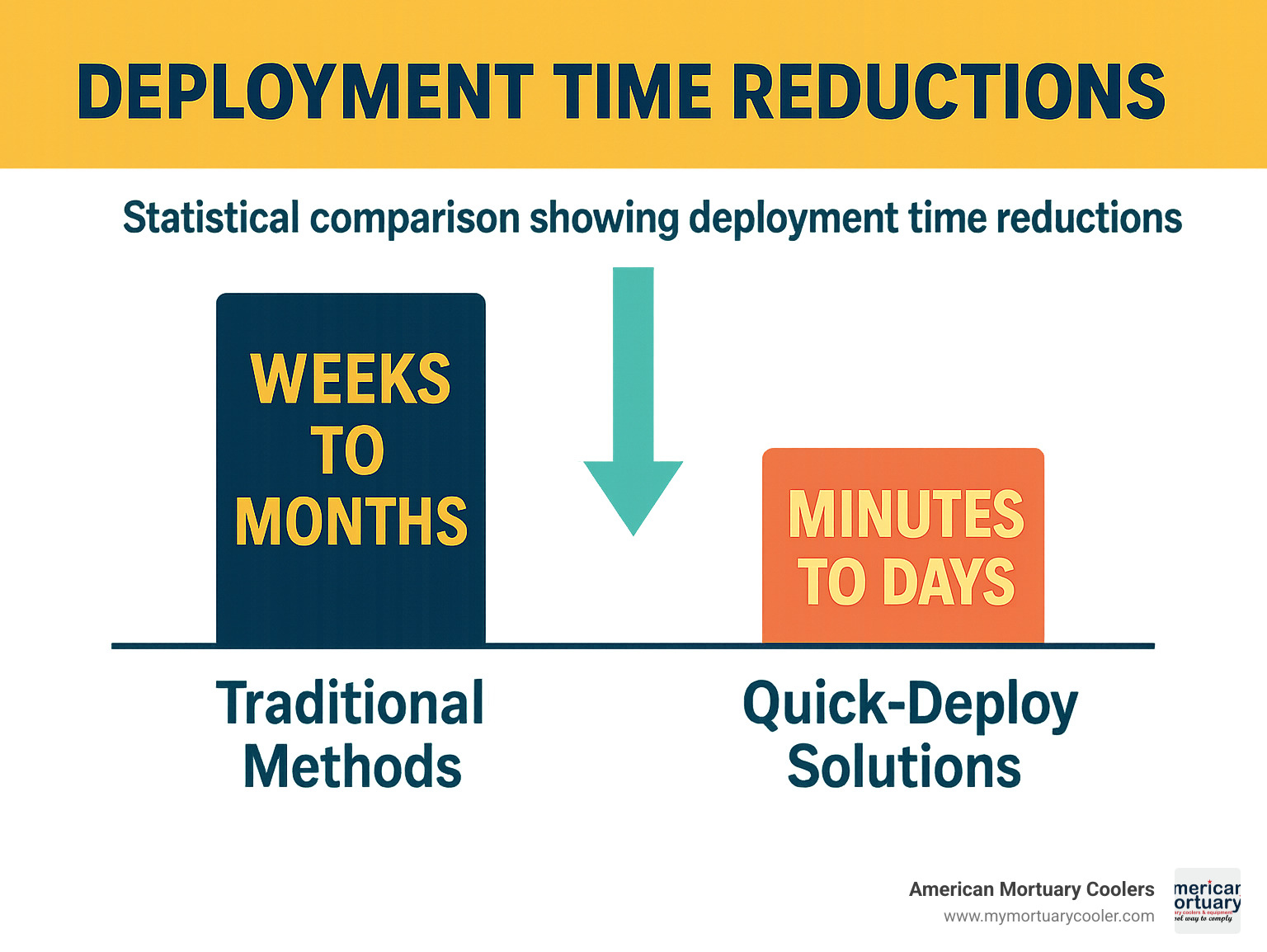
Frequently Asked Questions about Quick-Deploy
How does quick-deploy- cut deployment time so drastically?
The magic behind quick-deploy- solutions lies in doing the hard work upfront so you don't have to. Think of it like getting a pre-assembled piece of furniture instead of staring at a pile of parts and a confusing instruction manual.
These solutions achieve their speed through pre-configuration, where all the technical settings are already dialed in before you even receive the equipment. The FTS Quick Deploy Portable Weather Station perfectly demonstrates this approach - it arrives at your location already configured to your specifications. You simply unpack it, extend the telescoping mast, plug it in, and it immediately starts sending weather data. No laptop required, no technical wizardry needed.
Automation handles the heavy lifting in cloud deployments. AWS Quick Starts use Infrastructure as Code templates that automatically perform hundreds of manual tasks in sequence. Instead of spending hours clicking through setup screens and configuring servers, the system does it all for you. The AWS OpenVPN Quick Start can deploy complete VPN infrastructure in about 2 minutes because every step is automated.
Standardization eliminates the paralysis of too many choices. Citrix DaaS Quick Deploy automatically creates resource locations with two Cloud Connectors using proven configurations. While this approach limits your customization options, it virtually guarantees a successful deployment because the settings have been tested thousands of times.
What prerequisites are needed before triggering a quick-deploy?
Here's the good news - quick-deploy- solutions are designed for real people, not just IT experts. The prerequisites focus on basic access and environment rather than deep technical knowledge.
For cloud deployments, you typically need account credentials and basic information about your setup. The AWS OpenVPN Quick Start requires an AWS account with standard permissions and simple details like which VPC and subnet you want to use. Citrix DaaS Quick Deploy needs your Citrix Cloud account and Azure connection - information your IT team should have readily available.
Hardware solutions keep things even simpler. The FTS weather station needs a suitable location and power source, but that's about it. No tools, no technical training, no complicated installation process. Quick-deploy bipods just need a compatible mounting system like Picatinny or M-LOK rails, then they deploy with spring-loaded mechanisms in under a second.
Software platforms may require existing infrastructure, but they often handle missing pieces automatically. The elastic quick-deploy script checks for Docker and Docker-Compose, then installs them if they're missing. Gearset Quick Deploy needs access to your CI system and previously validated code branches.
The key difference from traditional deployments is refreshing - instead of requiring detailed technical specifications and manual configuration expertise, you just need basic access and a clear idea of what you want to accomplish.
Can I customize or scale a quick-deploy after it goes live?
Most quick-deploy- solutions understand that your needs will grow and change over time. They're designed as launching pads, not dead ends.
Customization options vary depending on the platform. Citrix DaaS Quick Deploy starts with basic Azure configurations, but you can convert those catalogs to full configuration management when you need advanced features. It's like starting with a studio apartment and later expanding to a full house - the foundation is already there.
Scaling capabilities are often built right into the system. Kubernetes Deployments can automatically adjust the number of running instances based on demand. The bcgov quickstart OpenShift template includes features like Pod Disruption Budgets that keep your applications running smoothly even as they grow.
Post-deployment expansion typically means graduating to more powerful management tools. DocLink Quick Deploy gets you operational in 30 days with their proven methodology, but you can add modules and integrations afterward. It's like learning to drive with an automatic transmission before moving to a manual - you get the basics down first.
Hardware solutions often emphasize modularity from the start. The Mortech MERC System is designed to be portable, scalable, and interoperable, so you can add more units as your needs expand. Quick-deploy bipods can move between different weapon systems using standard mounting interfaces.
The pattern is encouraging - quick-deploy solutions provide solid starting points with clear paths forward. If you need extensive customization from day one, traditional deployment might be better. But for most situations, starting with quick-deploy and expanding later proves both faster and more cost-effective.
Conclusion
The journey through quick-deploy- solutions reveals fundamental changes across industries. Whether watching AWS Quick Starts automate complex cloud infrastructure in minutes or seeing fire crews reposition weather stations in under 30 minutes during critical burns, the pattern is clear: speed and simplicity are winning over complex customization.
The numbers tell a compelling story. DocLink customers save up to $100,000 annually with 30-day deployment. Fire management teams respond to changing conditions in real-time instead of spending hours repositioning equipment. These aren't just efficiency gains - they're game-changers for time-critical challenges.
Let's be honest about trade-offs. Quick-deploy- solutions often mean accepting standardized configurations over custom setups. You might work within vendor-defined parameters rather than building exactly what you envisioned. The key is knowing when this trade-off makes sense.
The future looks bright for rapid deployment technologies. Infrastructure as Code is getting smarter, hardware solutions more automated, and industry-specific templates address specialized needs. We're moving toward a world where deployment complexity becomes someone else's problem - solved once and shared many times.
At American Mortuary Coolers, we've witnessed how quick-deploy- solutions transform emergency response in the funeral industry. When disasters strike or unexpected events overwhelm existing capacity, our rapid-deploy cooling systems help facilities expand quickly while maintaining dignity and preservation standards families deserve.
The beauty of quick-deploy solutions lies in their readiness factor. They're like well-stocked emergency kits - you hope you won't need them urgently, but when you do, you're incredibly grateful they exist. Whether managing cloud infrastructure that needs overnight scaling, field operations that can't wait for traditional setup, or emergency response where every minute matters, these solutions deserve a place in your planning.
Ready to explore what quick-deploy- can do for your operations? Start by identifying your biggest deployment headaches - those moments when you need something working yesterday. Then look for solutions addressing those specific pain points. Investment in rapid deployment capabilities often proves its worth precisely when you need it most.
More info about Quick Chill mortuary solutions provides additional guidance for funeral industry applications and emergency response planning.
















